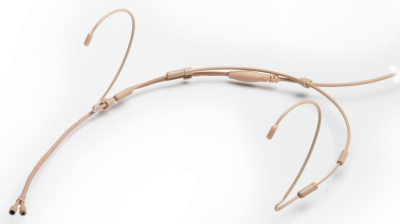At first glance, headset, lavalier and podium microphones all appear to be relatively simple, but a closer look reveals that there’s a lot more going on than meets the eye.
All three mic types offer many advantages for a range of live sound applications, with manufacturers continuing to come up with further innovations. Let’s have a look at each category.
Headset
Also commonly referred to as “headworn” and “earworn,” these mics are increasingly invisible while allowing complete freedom of movement as well as clear sound and very good gain before feedback. They’re particularly popular in theatrical applications as well as numerous spoken-word applications at houses of worship and corporate events.
They have a stiff-wire structure that loops around one or both of the user’s ears, with a thin adjustable boom extending along the cheek to place the mic capsule off the side of the mouth. It’s important to take care that the mic is not too close to the mouth or it can produce thumping sounds from breath pops.
Recent headset models are outfitted with elements that are extremely small, and they’re usually available in a range of colors to match common skin tones to render them even less visible. For example, the Countryman E6 Earset element is only 1/10 inch in diameter and has snap-on cables for use with a variety of wireless transmitters.
Usually an omnidirectional polar pattern is sufficient to reject feedback because the mic is so close to the mouth. There are several good choices; for example, the DPA d:fine 4000 Series of omnidirectional headset mics have now joined by the just-introduced d:fine CORE 6066 headset with an element measuring 1/8 inch, which is 60 percent smaller than the 4000 Series.

At the same time, the element incorporates the company’s new CORE amplification technology designed to reduce distortion and increase dynamic range while carrying an IP58 waterproof rating. (DPA also offers two lavalier models with this technology.)
Also recent on the development front is the CO2 Confidence Collection from Point Source Audio, available in headset, lavalier, and patented EMBRACE earmount version. They have dual elements for redundancy in a very slim form factor that’s based on the company’s omnidirectional single 1/8-inch element.

The backup element is fashioned to the existing mic in tandem and the independent and continuous wire paths are integrated into a singular wire jacket that split approximately 9 inches above connection to bodypacks to allow ample room for separation of the transmitters.
All integrate an IP57 waterproof rating, while the headset’s boom is bendable to 360 degrees for durability.
For a little more isolation, unidirectional models work well. Two popular examples are the Audio-Technica ATM73A (cardioid) and Countryman ISOMAX (cardioid and hypercardioid).
Lavalier
Lavalier mics, usually feeding a wireless body pack, present a wealth of additional options. While headworn designs have really come on, lavs aren’t on their way out any time soon.
Theatrical productions like to conceal miniature lavs in costumes, hairlines and even beards, where they’re virtually invisible. Lavs also make for quick and easy changes between presenters, and some presenters simply don’t like wearing a mic on their head. Many models also offer the ability to place two mics in a double clip so there is a backup in place, at the ready. These dual setups are most commonly found in theater and broadcast.
Lavs are available in a variety of shapes and sizes, with the trend being as small as possible. Despite shrinking in stature, however, performance is bigger and better than ever. As noted earlier, many of the technologies found in headworn mics is also a staple of lavalier designs, such as in the DPA d:screet CORE and Point Source CO Confident Collection lines.
The genre presents a wide range of options. A predominant choice over several decades now is the Sennheiser MKE2, and it still delivers thoroughly modern performance, with a wide frequency response (20 Hz to 20 kHz, +/-3 dB) and a stated SPL rating of 142 dB. More recent is the ME2, an omni clip-on lav with a mini jack for body pack transmitters from the company’s evolution wireless series.
Countryman makes what’s easily one of smallest directional lavs available in the form of the B2D. It can be ordered wired to an XLR or terminated for most popular wireless systems. There are two sensitivity ratings: standard, for most uses; and mid gain, optimized for head miking that’s common in theatre. Meanwhile, the company’s B3 offers a set of three interchangeable capsules for tailoring sensitivity. As with many options in this genre, it is available with a selection of connectors for use with a variety of wireless bodypack transmitters.
The LC81 MD from the AKG’s MicroLite Series is a miniscule cardioid design with a diameter of 3/16 inch, while the LC82 MD omni lav is even smaller at a diameter of just 1/8 inch. Audio-Technica continues to supply range of lav choices, including the AT898 (cardioid) and AT899 (omni), both with a switchable low-frequency roll-off that reduces popping as well as an array of available accessories.



















